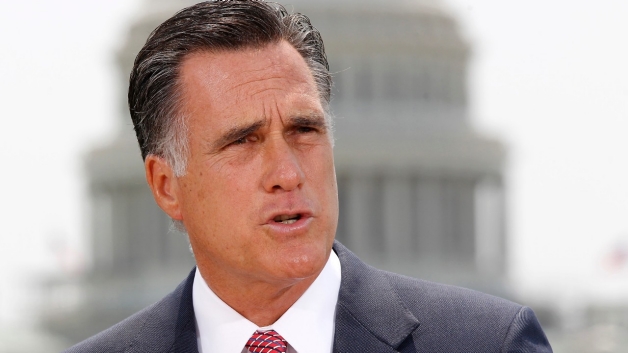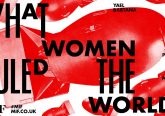 ‘President Obama has said that he wants to transform America. I don’t want to transform America; I want to restore the values of economic freedom, opportunity, and small government that have made this nation the leader it is.’ (4 April 2012, Remarks to the Newspaper Association of America)
‘President Obama has said that he wants to transform America. I don’t want to transform America; I want to restore the values of economic freedom, opportunity, and small government that have made this nation the leader it is.’ (4 April 2012, Remarks to the Newspaper Association of America)
It is less than a hundred days until the election for the most powerful political office in the world, the President of the United States of America. The November election ‘will be a defining event’. Not said by the usual peddlers of political commentary and punditry, but by the Republican nominee for President, Mitt Romney.
The US election of 2008 was monumental and arguably constituted a dramatic turning point in the political history of the United States. Gillian Peele and Joel D. Aberbach, two political academics, wrote:
Republicans are still stultified and angered by the depth and scope of the Democratic victory in 2008 and its symbolic rejection of the conservatism that had dominated the Bush presidency. The éminence grise of the Bush presidency, Karl Rove, hinted at the rejection of a ‘reality-based community’, for one in which reality was controlled by those in power. Rove infamously announced that ‘we create our own reality’. This perhaps sounds all too Orwellian, but the control of the horizon of expectations and what constitutes as ‘common sense’, both in terms of hegemony of concepts and histories, alludes to the competition over competing ideological visions of the country’s past, present and future. The reality of a Bush presidency was however unequivocal: environmental catastrophe, irresponsible tax cuts, which benefited the wealthiest Americans disproportionately, a divisive War on Terror and bequeathed the Obama administration the worst legacy since Franklin Delano Roosevelt replaced Herbert Hoover in 1932.
The election of Obama and the Democratic Party in Congress, for many observers, represented and symbolised the death of American conservatism and a reorientation of America’s public ideology towards progressive and liberal values. However, since the very inception of the Obama presidency a liberal discourse has not been ideologically dominant as many commentators in 2008 had predicted. At the 2010 congressional elections the Republicans mounted a superb turnaround in their electoral and political fortunes. Although sitting US President’s party’s lose seats in midterm elections (i.e. Democratic losses in 1994; Republican losses in 2006), the 2010 election resulted in the highest loss for a party in a House midterm election since 1938. The emphatic Republican victory, many of whom were Tea Party Republicans (Marco Rubio in Florida and Rand Paul in Kentucky). The obituaries of American conservatism in 2008 were soon torn-up, discredited and presented as premature. The Right, not the Left, is the insurgent force in American politics today.
The Right are insurgent because they are angered by the ‘new normal’ blighting America under President Obama: stubbornly high levels of unemployment and an economy experiencing anaemic growth. The Obama response to the financial crisis of 2008 with the American Recovery and Reinvestment Act in 2009 with its $831 billion stimulus investing in infrastructure, education, health, green technologies and an expansion of unemployment benefits/welfare provisions was ideologically unacceptable for most Republicans. Even though the Bush administration authorised the TARP program in order to address the subprime mortgage crisis, Republicans resisted the Obama administration’s efforts to resolve the financial crisis as it meant more spending, more debt and, most egregiously to the neo-liberal generation of Republicans, more government! The inevitability and prospect of a trillion dollar deficit as the ‘new normal’ under President Obama for Republicans is the stuff of nightmares.
Despite the ‘inflection point’ status attributed to the 2008 election, 2012 will be just as momentous, if not more so than 2008. The Pew Research Center’s report on ‘Partisan Polarization Surges in Bush, Obama Years’ contended that, ‘As Americans head to the polls this November, their values and basic beliefs are more polarized along partisan lines than at any point in the past 25 years.’ The divide between Republicans and Democrats is now far greater than gender, age, race or class divides. Nevertheless, it is the contention here that it is the Republicans that are the chief architects of this divide, as insurgent forces such as the libertarians and Tea Party movement has shifted the Republicans to the Right. Ergo, a President Romney would be more radical than a second-term President Obama. The 2012 Republican public proposals for America is arguably the most comprehensively Right-wing agenda since Barry Goldwater in 1964.
As early as the second month of the Obama presidency, an anti-Obama conservative grassroots movement was established called the Tea Party (firstly an allusion to the Boston Tea Party, which has long been used by anti-tax libertarians and conservatives to celebrate the virtues of non-interference and small government; and secondly an acronym for ‘Taxed Enough Already’ Party). Theda Skocpol and Vanessa Williamson’s thesis on the Tea Party referred to its two-pronged structure and character. Firstly, the Tea Party is composed of grassroots organisations. The grassroots support large elements of Social Security, Medicare and benefits for military veterans. Their antipathy to ‘Big Government’ entails reluctance to pay taxes for the ‘undeserving’, ‘welfare queens’, which include the young, immigrants and lower income earners. Secondly, the Tea Party is organised and financed by wealthy plutocrats such as the Koch Brothers and members of Club for Growth. Their aims are somewhat divergent from the grassroots. The elite Tea Party argue for maintaing the Bush tax cuts for the wealthy, deregulation of business and Wall Street (Romney has vowed to repeal the ‘Dodd-Frank’ Act and its implementation of the ‘Volcker rule’ and replace it with a ‘streamlined, modern regulatory framework’); and the privatisation of the same Social Security and Medicare programs, which the grassroots of the Tea Party movements value and critically support. These two groups are unified however by key Tea Party-affiliated organisations and advocate groups such as Americans for Prosperity; FreedomWorks and Tea Party Express. Nevertheless, as Skocpol and Williamson continually and pointedly emphasise, they are united in two objectives: to replace President Obama with President Romney and install a prospective President Romney and the Republican Party into Capitol Hill in order to move America to the Right. Importantly, Skocpol and Williamson reject the idea that the Tea Party is a racist organisation. It is instead a passionate grass roots and elite conservative reaction to Obama liberalism.
Elizabeth Price Foley in her latest book, The Tea Party: Three Principles, argued that the Tea Party has three core principles: limited government; an unapologetic support of US sovereignty; and constitutional originalism (i.e. the judicial philosophy practiced by conservative Supreme Court justices Scalia and Thomas). These principles broadly align themselves with the Republican Party public-policy portfolio and ideological platform in 2012 on health care reform, budget reforms (Romney and congressional Republicans support Representative Paul Ryan’s Plan for budgetary austerity and shrinking the scope and size of government), illegal immigration and the War on Terror.
All conservative ideologies gain definition through the use of the mirror-image characteristic. In other words, conservatism is a collection of negative dialectics, it is defined by what it is against. Romneyism is the purported mirror-image of Obamaism. Obama’s conception of the role of government and the state is quintessentially New Democrat. Obama has a belief in a social-investment State: the state/government working in harmonious cooperation with the private sector and the third sector. Contrarily, Republicans interpret this as a further example of the Obama administration’s proclivity for the overweening and overreaching role of government. For Romney’s Republicans, this is seen less as a cooperation between government and societal actors, but as an attempt for Obama to reduce the size and importance of society and the market. Obama last week uttered the following (now inflammatory) words at a speech at a campaign rally in Roanoke, Virginia: ‘If you’ve got a business, you didn’t build that. Somebody else made that happen.’ This simultaneously had the affect of pleasing the liberal wing of the Democrat Party and energising the Republican Party. Obama’s notion that wealth creation is an interdependent enterprise was decontested by Romney as wealthy, successful Americans owing their success to others and not themselves. For Romney’s Republicans, this revealed what they’ve always suspected and known: Obama is the big government, tax-loving, liberal statist who wants to ‘spread the wealth around’.  Obama’s true feelings on capitalism and entrepreneurship are thus revealed and thus discounts the efforts of the economically successfully and thus feels entitled to purloin more and more of the fruits of their labour. Romney’s response was expectedly quick and sharp: ‘I know there are some people who think that what the president said was just a gaffe. It wasn’t a gaffe. It was instead his ideology’. In the same speech President Obama put forward his reasons and rationale for increasing the taxes of the wealthiest, many of whom created their own businesses should be taxed at a higher rate (the pre-2001 rate of 39.6% under Clinton up from the 35% top rate of tax for most of the Bush presidency). Those that are fortunate, especially in an age of economic turbulence, owe a greater debt to society than they do currently. Democrats stress the interdependence of wealth creation whereas the Republicans accentuate the buccaneering spirit of the individual entrepreneur, who ruggedly create jobs and wealth through his or her own endeavours in an environment of creative destruction. Republicans see the Obama administration’s increase in taxes as an attempt at behaviour modification, to behave in the way Obama sees fit in line with his socialism. In Romney’s book, No Apology, he celebrates the ‘creative destruction inherent in the free economy’. The market, not the state, should dictate and discipline the nature of the lives of Americans.
Obama’s true feelings on capitalism and entrepreneurship are thus revealed and thus discounts the efforts of the economically successfully and thus feels entitled to purloin more and more of the fruits of their labour. Romney’s response was expectedly quick and sharp: ‘I know there are some people who think that what the president said was just a gaffe. It wasn’t a gaffe. It was instead his ideology’. In the same speech President Obama put forward his reasons and rationale for increasing the taxes of the wealthiest, many of whom created their own businesses should be taxed at a higher rate (the pre-2001 rate of 39.6% under Clinton up from the 35% top rate of tax for most of the Bush presidency). Those that are fortunate, especially in an age of economic turbulence, owe a greater debt to society than they do currently. Democrats stress the interdependence of wealth creation whereas the Republicans accentuate the buccaneering spirit of the individual entrepreneur, who ruggedly create jobs and wealth through his or her own endeavours in an environment of creative destruction. Republicans see the Obama administration’s increase in taxes as an attempt at behaviour modification, to behave in the way Obama sees fit in line with his socialism. In Romney’s book, No Apology, he celebrates the ‘creative destruction inherent in the free economy’. The market, not the state, should dictate and discipline the nature of the lives of Americans.
Romney looks to the high peak of Reagan’s America, when the top rate of tax was 28% (1988-1989). Reagan had a greater challenge than Romney however. President Reagan cut the top rate of tax from 70% to 28% over the eight years of his presidency, with a largely hostile Democratic-controlled House of Representatives under the New Deal Democrat stalwart Speaker Tip O’Neill. In order to convince recalcitrant and apathetic Reagan-admirers, Romney proposed cutting the top rate of income tax for individuals to 28%. Other Romney proposals include the elimination of the estate tax (death/inheritance tax); elimination of the Alternative Minimum Tax Repeal; cutting the top rate of tax from 35% to 28%; a 20% cut in marginal rates; and a pledge to maintain current tax rates on interest, dividends and capital gains. Glenn Hubbard, Romney’s senior economic adviser, has proposed a restoration of what critics of tax cuts being the sole source of reviving a stagnant economy call ‘trickle-down economics’. The argument of the proponents of trickle-down economics is straightforward and glib: if top income earners are taxed less then they will invest more into businesses, infrastructure and equity markets. This will consequently lead to more goods at lower prices, and create more jobs for middle and working class individuals. Economic growth thus trickles down, a Heraclitean flow from the banker to the street-sweeper.
The trickle-down economics propounded by Romney has been largely discredited for a number of different reasons, chief among those is the largely dominant standing of trickle-down economics in the golden era of neo-liberalism, in which the financial system crashed in 2008, unleashing an unprecedented series of government interventions, recapitalisations and nationalisations across the Atlantic, bringing in a credit crunch and a prospective decade of depression, austerity and political turbulence. G. H. W. Bush, when running against Reagan for the Republican nomination for President in 1980, called Reagan’s trickle-down economics (or Reaganomics) ‘voodoo economics’. Ross Perot in his 1992 presidential run said something similar, equating trickle-down economics, in theory and in practice, as voodoo. The Bush 43 presidency ushered in a package of far-reaching and controversial tax cuts from the beginning (Economic Growth and Tax Relief Reconciliation Act of 2001) and (Jobs and Growth Tax Relief Reconciliation of 2003). These acts significantly lowered the marginal tax rates for nearly all US taxpayers. Congressional Budget Office estimated in June 2012 that the Bush tax cuts (both acts) added about $1.6 trillion to the debt between 2001 and 2011. The devastating legacy of the Bush tax cuts as witnessed during the financial crisis of 2008-2010, a turbo-charged experiment in trickle-down economics, had put the nail in the coffin for this experiment. Maybe not? Arthur Laffer, member of Reagan’s Economic Policy Advisory Board from 1981-89 and powerful advocate of supply-side economics, constructed the ‘Laffer Curve’ to support the trickle-down approach of the Reagan (and Bush) tax cuts. The graph is a hypothetical representation of the relationship between government revenue raised by taxation and all possible rates of taxation. Fundamentally, the taxable income will change in response to changes in the rate of taxation. The Bush administration had claimed, using the Laffer Curve, that the tax cuts actually paid for themselves by generating enough extra revenue from additional economic growth to offset the lower taxation rates. Laffer broadly supports Romney’s economic plan for American recovery.
Ross Perot in his 1992 presidential run said something similar, equating trickle-down economics, in theory and in practice, as voodoo. The Bush 43 presidency ushered in a package of far-reaching and controversial tax cuts from the beginning (Economic Growth and Tax Relief Reconciliation Act of 2001) and (Jobs and Growth Tax Relief Reconciliation of 2003). These acts significantly lowered the marginal tax rates for nearly all US taxpayers. Congressional Budget Office estimated in June 2012 that the Bush tax cuts (both acts) added about $1.6 trillion to the debt between 2001 and 2011. The devastating legacy of the Bush tax cuts as witnessed during the financial crisis of 2008-2010, a turbo-charged experiment in trickle-down economics, had put the nail in the coffin for this experiment. Maybe not? Arthur Laffer, member of Reagan’s Economic Policy Advisory Board from 1981-89 and powerful advocate of supply-side economics, constructed the ‘Laffer Curve’ to support the trickle-down approach of the Reagan (and Bush) tax cuts. The graph is a hypothetical representation of the relationship between government revenue raised by taxation and all possible rates of taxation. Fundamentally, the taxable income will change in response to changes in the rate of taxation. The Bush administration had claimed, using the Laffer Curve, that the tax cuts actually paid for themselves by generating enough extra revenue from additional economic growth to offset the lower taxation rates. Laffer broadly supports Romney’s economic plan for American recovery.
President Obama is offering continuity, not change, in 2012. By 2014, the American people will feel the benefits of the Affordable Care and Patient Protection Act and wealthy Americans will face an increase in their margins of federal income tax. Obama’s second term will preserve the liberal centrism of the first term and it may endure. However, what is Romney’s vision of America? Is it to restore America before the dawn of Obama? Is Governor Romney offering a Reaganite 1980s redux? Perhaps it is an arcadian nostalgia for pre-New Deal America? Garland Tucker has contended that President Calvin Coolidge could be an attractive role model for Romney. Coolidge (‘Silent Cal’) was the hero of the intellectual conservative revivalists of the Reagan era. The advent of Reagan and the revival of American conservatism resulted in a comprehensive reappraisal of Coolidge’s political and historical legacy. Coolidge was the President of the US for most of the 1920s and presided over a period of American history that is indelibly synonymous with free-market enterprise, limited government and constitutional restraint (the Lochner era of the Supreme Court). Listening to Romney, you’re reminded of one of Coolidge’s mottos about the spirit and purpose of America, ‘the chief business of the American people is business’. It was Romney who said that ‘corporations are people too’. The Coolidge Administration’s record is certainly something that contemporary Republicans would admire and revere. Coolidge managed to cut the top marginal rate of tax from 73% to 24%; by the end of his term of office 98% of the population paid no income tax; the federal budget was reduced by 35%; per capita income increased over 30%; unemployment averaged 3.3% and GNP grew at the fastest compound rate of any eight-year period in U.S history. Will Hutton, the social democratic journalist, claims that Romney embodies a casino capitalism that animated the neo-liberal era of capitalism in the 1980s, 1990s and 2000s. Romney focuses on the innovation of the free market. It is the sphere of society that deals with risk and dynamism. ‘Obama has begun’, Hutton comments, ‘the counter-argument. Innovation is necessarily about taking risks and unless there are mechanisms to share them between the private and public sectors, the risks and innovation are necessarily not undertaken.’
Coolidge (‘Silent Cal’) was the hero of the intellectual conservative revivalists of the Reagan era. The advent of Reagan and the revival of American conservatism resulted in a comprehensive reappraisal of Coolidge’s political and historical legacy. Coolidge was the President of the US for most of the 1920s and presided over a period of American history that is indelibly synonymous with free-market enterprise, limited government and constitutional restraint (the Lochner era of the Supreme Court). Listening to Romney, you’re reminded of one of Coolidge’s mottos about the spirit and purpose of America, ‘the chief business of the American people is business’. It was Romney who said that ‘corporations are people too’. The Coolidge Administration’s record is certainly something that contemporary Republicans would admire and revere. Coolidge managed to cut the top marginal rate of tax from 73% to 24%; by the end of his term of office 98% of the population paid no income tax; the federal budget was reduced by 35%; per capita income increased over 30%; unemployment averaged 3.3% and GNP grew at the fastest compound rate of any eight-year period in U.S history. Will Hutton, the social democratic journalist, claims that Romney embodies a casino capitalism that animated the neo-liberal era of capitalism in the 1980s, 1990s and 2000s. Romney focuses on the innovation of the free market. It is the sphere of society that deals with risk and dynamism. ‘Obama has begun’, Hutton comments, ‘the counter-argument. Innovation is necessarily about taking risks and unless there are mechanisms to share them between the private and public sectors, the risks and innovation are necessarily not undertaken.’
Romney wants to go back to the world of President Reagan in the White House, Alan Greenspan under the intellectual influence of Objectivist philosopher Ayn Rand in the Federal Reserve and a world where the triumph of liberal capitalism constituted the ‘end of history’. Greenspan, the doyen of the neo-liberal banking structure, said in 2008 following the banking crisis that he had found a flaw in the ‘critical functioning structure that defines how the world works…I made a mistake in presuming that the self-interests of organisations, specifically banks and others, were such that they were best capable of protecting their own shareholders and their equity in the firms.’ However, this widespread scepticism of the merits of the free market has given way to a powerful critique of the state and the government insofar as the state did not only exacerbate the economic downturn, but was the source of its creation.
Romney, and by extension Romneyism, is offering a ‘return to normalcy’. Romney’s ‘normal’ is the old consensus, the consensus before the financial crisis: the state is the problem, markets work, taxes should be lowered at the top end of the income scale in order to trickle-down and collective bargaining and unions should be weakened. Romney is a ‘retro-conservative’ promising ‘a return to normalcy’ in the way President Harding declared in his inauguration address in 1921 after the eight years of energetic liberal idealism of the Woodrow Wilson presidency. This ‘return to normaly’ is not merely economic. There are social and cultural prescriptions that indicate a further dimension to Romney’s Republic restorationism. The Republican Party under Romney is against federal gay marriage; against the Obama Administration’s revocation of Don’t Ask Don’t Tell; restriction of birth control and hinted at creating a Supreme Court that will overturn Roe Vs. Wade.
Cohen suggested that 2008 was an election between Obama (the candidate of change) vs. McCain (the candidate of continuity). 2012 in contrast is an election between Obama (continuity) vs. Romney (restoration).  This election is a referendum on the Obama Transformation. Americans will be asked, ‘Do Americans want to complete the transformation or move ‘forward to the past’ furnished with conservative nostalgia for the non-progressive periods of American history? The battleground, as argued, is centred around the role of government and the extent and scope of the state in American society. Romney in a speech on ‘Freedom and Opportunity’ on 30 March 2012 set up a binary opposition: the Republicans offered America an ‘Opportunity Society’ and the Democrats an ‘Obama Government-Centred Society’. Charles Krauthammer, a conservative syndicated columnist, accused Obama (after his ‘if you’ve got a business – you didn’t build that’ comment) of dangerously conflating ‘society with government, the collectivity with the state.’ Conservatism, after the halcyon days of Anglo-American Thatcher-Reagan 1980s, deemphasizes its closeness to markets and emphasises the need to protect civil society. ‘It is civil society, those elements of the collectivity that lie outside government: family, neighborhood, church, Rotary club, PTA, the voluntary associations that Tocqueville understood to be the genius of America and source of its energy and freedom.’
This election is a referendum on the Obama Transformation. Americans will be asked, ‘Do Americans want to complete the transformation or move ‘forward to the past’ furnished with conservative nostalgia for the non-progressive periods of American history? The battleground, as argued, is centred around the role of government and the extent and scope of the state in American society. Romney in a speech on ‘Freedom and Opportunity’ on 30 March 2012 set up a binary opposition: the Republicans offered America an ‘Opportunity Society’ and the Democrats an ‘Obama Government-Centred Society’. Charles Krauthammer, a conservative syndicated columnist, accused Obama (after his ‘if you’ve got a business – you didn’t build that’ comment) of dangerously conflating ‘society with government, the collectivity with the state.’ Conservatism, after the halcyon days of Anglo-American Thatcher-Reagan 1980s, deemphasizes its closeness to markets and emphasises the need to protect civil society. ‘It is civil society, those elements of the collectivity that lie outside government: family, neighborhood, church, Rotary club, PTA, the voluntary associations that Tocqueville understood to be the genius of America and source of its energy and freedom.’
Krauthammer is something of an endangered species in the Republican jungle insofar as he is both erudite and moderate. Krauthammer contends that Republicans do not abnegate the state carte blanche, but wish to limit its scope and reach beyond infrastructure. ‘Beyond infrastructure’, Krauthammer dictates, ‘the conservative sees the proper role of government as providing not European-style universal entitlements but a firm safety net…those too young or too old, too mentally or physically impaired, to provide for themselves.’
Similar binary oppositions have been erected to expose the strength of Conservative ideology in contemporary British politics. The Cameronite language of the Big Society is held up in opposition to the Big Government of the (New) Labour Party. David Miliband in September 2008, as Foreign Secretary in the Brown Government, said something similar in effect to Obama, ‘…unless government is on your side you end up on your own. David Cameron, then Leader of the Opposition, quickly jumped on this – ‘…there is a dangerous argument doing the rounds…Labour are clutching at it as some sort of intellectual lifeline…In these times of difficulty, we need a bigger state….A Labour minister said something really extraordinary…David Miliband said that ‘unless government is on your side you end up on your own.’ ‘On your own’ – without the government. I thought it was one of the most arrogant things I’ve heard a politician say.’
‘The president’, Romney pronounced, ‘has pledged to transform America. And he’s spent the last four years laying the foundation for a new government-centered society. I will spend the next four years rebuilding the foundation of a opportunity society led by free people and free enterprises.’ Despite the numerous attacks on Obama and the record of his administration, Romney’s political offerings to America still seem vague and confused How do we account for the vagueness? There is lack of a clear health care scheme or lack of policies on education. One of the reasons for this apparent vagueness is Romney’s aspiration, rhetorically, to return power to the states. This amounts to a fresh round of Reaganite New Federalism. ‘For many Americans’, Cohen writes, ‘Romney’s rhetorical insistence that he will return responsibilities to the 50 states and reduce the involvement of the federal government in the lives of the American people is what makes his presidency an appealing possibility.’ Mitt Romney is ‘appealing to past glory, imperial power and manifest destiny.’
Raymond Plant in his Modern Political Thought distinguishes between maximalist (the ‘telocratic’ state) and minimalist (the ‘nomocratic’ state) approaches to politics. Maximalist ideas align themselves to a liberal, social democratic, transformative politics (i.e. the realisation of particular ends and goals). Maximalist politics is, according to Plant, ‘concerned not only with structures and procedures but rather with ends such as social justice, and will search for institutions and policies that will secure such collective ends. It is concerned with virtues, not just rules.’ Minimalist politics, in contrast, avoids the need for elabourated conceptions of the human good and only require general judgements about the needs, desires, capacities, opportunities and resources that are of fundamental importance. The minimalist politics ‘is concerned with the structure of the framework of non-coercion and rights that have to be in place within which individuals can pursue their own good in their own way so long as in pursuing that good they do not interfere with the freedom of others to do the same.’ There are two elements of the political minimalism that are applicable to the Republican conservatism espoused by Romney. Firstly, there is a discernible lack of support among Americans for deploying public policy for purposes of long-term social redistribution. According to Alan Ware, the ‘New Deal would never have received backing from a majority of Americans had its principal ethos been that of transferring resources in the long term to the country’s “have nots”‘. Secondly, there is a widespread acceptance in the US that, if goods and services can be supplied adequately by the private sector, the private sector should be left without interference and thus the state should not get involved.
Romney Republicanism is therefore a variant of a minimalist, nomocratic conservatism aiming to restore the idea of the social minimum (reversing the enlargements added by the Obama Administration); the depoliticisation of swathes of American society (i.e. deregulation, desocialisation, liberalisation and debureaucratisation) and shrink the size of government in economic affairs. Romney wants ‘ordered liberty’: freedom with decency, liberty without licence. Behind the vagueness and intentional obfuscation lies a consistently conservative vision of the American future that wants to bring America forward to the past. Romneyism is a revivalist ideology seeking to revive the values of a ‘vanished country’ found in the voluntary associations of ‘real America’, which have been overshadowed by the liberal progressivism of Obama and the liberal elite. Romney’s central theme is restoration in juxtaposition to Obama’s transformative continuity.








No Comment